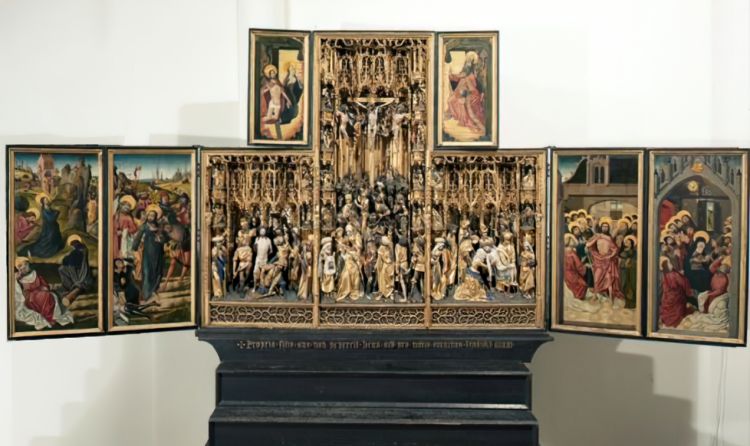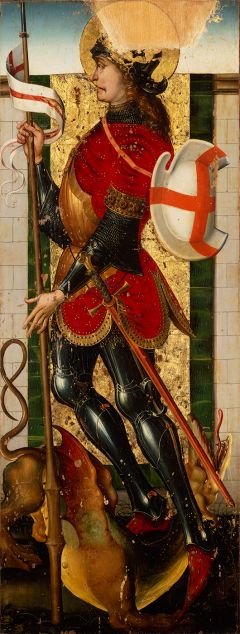The triptych over the altar in the Chapel dates from the 1480s and is attributed to the unknown Master of the View of Sainte-Gudule. [1988; 1989; 1991]
The scenes depicted in each panel are:
- The Betrayal, with the Agony in the Garden of Gethsemane (Mount of Olives) in the background.
- The Resurrection, with the Appearance to Mary Magdalene in the background.
- The Appearance to the Disciples (and Mary Magdalene, lower left), with the Journey to Emmaus in the background.
The reverse sides of the panels
On the reverse of each panel, there are depictions of saints:
The rear panels represent:
- St Catherine of Alexandria (seen without her wheel, but with a sword, and trampling on the tyrant Maximin);
- St George (seen subduing a dragon);
- St Barbara (holding a tower).
They now suffer from considerable loss of paint, but have been stabilised as seen above. These panels have not been seen since 1993.
The wood panels are probably the remnants of a much larger altarpiece. This belief stems from (a) the panels being painted on both sides; and (b) the panels being similar to double-sided painted panels on other known early Flemish altar-pieces, such as:
- The “Flemish Altarpiece” at the Bowes Museum, Barnard Castle;
- The “Altarpiece of the Passion” at Sint-Dimpnakerk, Geel, Belgium.
Such altarpieces consisted of a carved wood central panel, with wing panels painted on both sides, on hinges, that could be folded over to close off the central carved wood panel. Being painted on both sides, the panels displayed images in both configurations.
Chronology of the panels
It is not known for certain how and when the triptych panels came to the College [but see Woods 2002]. It seems improbable that, had they been in college then, they could have survived the visit of the iconoclast William Dowsing in December 1643. The earliest reference to the triptych so far found is in an inventory of the Long Gallery taken in March 1717: [QC Old Lib MS75 p. 144]
A Picture of the Passion of our Sav.
In his notebook for 1741–52, George Vertue recorded seeing:
Cambridge At Queens Coll. in the Masters Lodge large flat paintings in oyl after the manner of Albert Dure representing several of our Saviours Miracles.
[1938 p. 19]
Anne Plumptre, daughter of Robert Plumptre, President of Queens’ 1760–88, in comparing the Queens’ triptych with a four-panel artwork in the cathedral at Aix, recollected that the Queens’ triptych had been mounted at the end of the Long Gallery when she had been a child in the Lodge. She went on to speculate:
It seems by no means an ill-founded conjecture that the picture in Queen’s lodge was given by the foundress of the college, Margaret of Anjou, the daughter of king Renè, and wife of our Henry the Sixth, to ornament the chapel; but on the overthrow of the Catholic religion, when pictures were no longer allowed in the chapel, was removed to the lodge.
[Plumptre, 1810, Vol 2, pp. 341–2]
Her speculation was reproduced uncritically by subsequent historians, but unfortunately her conjecture was completely ill-founded: the panels are now considered to have been painted long after Margaret has been deposed from the crown, and possibly even after her death in 1482.
In 1790, the triptych was described as:
A curious Altar Piece from the Chapel in 3 Pannels, Judas betraying our Saviour, the Resurrection, and Christ appearing to the Apostles after the Resurrection.
… These Pictures are very much in the style of Martin Schoen, they are in the highest possible preservation, and are a most invaluable curiosity
[1790, p. 20]
This text, and its suggested attribution, were reproduced uncritically in subsequent guide-books and histories. For the reason given above, it is improbable that the triptych panels were in the old college chapel.
The triptych was incorporated into the reredos over the altar of the new college chapel by architect George Frederick Bodley in 1891.
In the Illustrated History by Browne & Seltman, the attribution to Schoene was doubted [1951].
In 1982, when one of the panels was taken down from the reredos for conservation by Alec Cobbe, the paintings on the back of the panels were re-discovered.
The first person to attribute the panels to the Master of the View of Sainte-Gudule was Jean Michel Massing, acting Director of Studies in the History of Art at that time, in a letter dated 3 November 1982 to the Keeper of the Pictures, Dr Peter Spufford. Further investigations followed [1983; 1988; 1991].
In 1993, after conservation of the panels had been completed, they formed the centrepiece of the ‘Splendours of Flanders’ exhibition in the Fitzwilliam Museum, where it was possible to see both sides of the panels for the first, and only, time.
Altarpieces with similar panels by the same artist
These altarpieces provide a guide to the possible design of a former altarpiece from which the three panels at Queens’ survive.
The “Flemish Altarpiece” at the Bowes Museum.
 Bowes Altarpiece with side panels open.
Bowes Altarpiece with side panels open.
Upper row:
- Painted: God the Father (mirror-image at Geel)
- Painted: Adoration of the Magi
Lower row (the Passion):
- Painted: Gethsemane (similar to Geel)
- Painted: Pontius Pilate
- Carved: Flagellation
- Carved: Crown of Thorns / Carrying the Cross
- Carved: Crucifixion
- Carved: Deposition
- Carved: Entombment
- Painted: Resurrection (similar to Queens’)
- Painted: Appearance to the Disciples
 Bowes Altarpiece with side panels closed.
Bowes Altarpiece with side panels closed.
Upper row:
- St Anthony (similar to Geel)
- Family of Zebedee
Lower row:
- St Gregory
- St Jerome
- St Augustine
- St Ambrose
The “Altarpiece of the Passion” at Sint-Dimpnakerk, Geel, Belgium
 Geel Altarpiece with side panels open
Geel Altarpiece with side panels open
Upper row:
- Painted: Jesus with Mary
- Painted: God the Father (mirror-image at Bowes)
Lower row (the Passion):
- Painted: Gethsemane (similar to Bowes)
- Painted: Betrayal (re-arrangement of same at Queens’)
- Carved: Flagellation
- Carved: Crucifixion
- Carved: Deposition
- Painted: Appearance to the Disciples
- Painted: Pentecost
 Geel Altarpiece with side panels closed
Geel Altarpiece with side panels closed
Upper row:
- St Anthony (similar to Bowes)
- St Nicholas
Lower row:
- St George
- St Catherine
- St Barbara
- St Adrian
The first three of these saints are the same saints as depicted at Queens’, in different poses.
Layout of possible altarpiece with Queens’ panels
A conjectural outline of the altarpiece from which the Queens’ panels survive, based on similar Flemish or Netherlandish altarpieces:
 Possible source altarpiece - open
Possible source altarpiece - open
Lower row (the Passion):
- Painted: Betrayal
- Painted: (unknown)
- Carved: (unknown, probably Crucifixion)
- Painted: Resurrection (similar to Bowes)
- Painted: Appearance to the Disciples
 Possible source altarpiece - closed
Possible source altarpiece - closed
Lower row:
- (unknown)
- St Catherine
- St Barbara
- St George
Credits
Research by Jean Michel Massing and Hélène Dubois. Panel restoration by Alec Cobbe. Photography of the panels by Christopher Hurst on 5″ × 4″ colour transparencies, ca. 1993. Digitised and colour-corrected by Robin Walker 2021.
References and Further Reading
1790: A catalogue of the several pictures in the public library and respective colleges, in the University of Cambridge, by A Gentleman of the University
, p. 20. (OCLC 390916796)
1810: A Narrative of Three Years’ Residence in France, by Anne Plumptre, Vol 2, pp. 341–2. (OCLC 2949362)
1938: Vertue’s note book A.y.y. (British Museum, Add. MS. 23,073), in Vertue note books: Volume V, The Volume of the Walpole Society, Vol. 26, p. 19. (OCLC 3266645)
1951: A Pictorial History of the Queen’s College of Saint Margaret and Saint Bernard, commonly called Queens’ College Cambridge, 1448–1948, by Archibald Douglas Browne (1889–1977) & Charles Theodore Seltman, plates 110–113. (OCLC 7790464)
1983: The College Pictures, by Peter Spufford, in Queens’ College Record 1983, p. 7.
1988: Le Maître à la vue de Sainte-Gudule: Contribution à l’étude critique de son œuvre, by Hélène Dubois, Mémoire de Licence, Université Libre de Bruxelles. (OCLC 845084940) [2 vols]
1989: Sources d’inspiration du Maître à la Vue de Sainte Gudule et de son atelier, by Hélène Dubois, in Annales d’Histoire de l’Art et d’Archéologie, Vol. XI, pp. 39–52. (ISSN 0771-2723) [includes chapel triptych]
1990: The Triptych, by Peter Spufford, in Queens’ College Record 1990, pp. 10–11.
1991: Three panels by the Master of the View of Ste-Gudule in the Chapel of Queens’ College, Cambridge, by Jean Michel Massing, The Burlington Magazine 133 (Oct 1991), pp. 690–3. (ISSN 0007-6287)
1993: Splendours of Flanders: Late medieval art in Cambridge collections, by Alain Arnould and Jean Michel Massing, with contributions from Peter Spufford [Fellow] and Mark Alistair Sinclair Blackburn. (ISBN 978-0-521-44157-5, 978-0-521-44692-1) [Catalogue of Fitzwilliam Museum exhibition including Queens’ triptych]
2002: The Pre-Reformation Altarpiece of Long Melford Church, by Kim W. Woods, in The Antiquaries Journal, Vol. 82, Sept. 2002, pp. 93–104 (ISSN 0003-5815 eISSN 1758-5309) [speculative connection between Long Melford altarpiece and Queens’ triptych]
2008: The Altarpieces in the College Chapel, by Peter Spufford, in Queens’ College Record 2008, pp. 26–27.
2016: The Speelman Fellowship and Netherlandish Art in Cambridge, by Jean Michel Massing & Meredith McNeill Hale, in Cambridge and the Study of Netherlandish Art, ed. Meredith McNeill Hale, pp. 15–45. (ISBN 978-2-503-56634-4)





